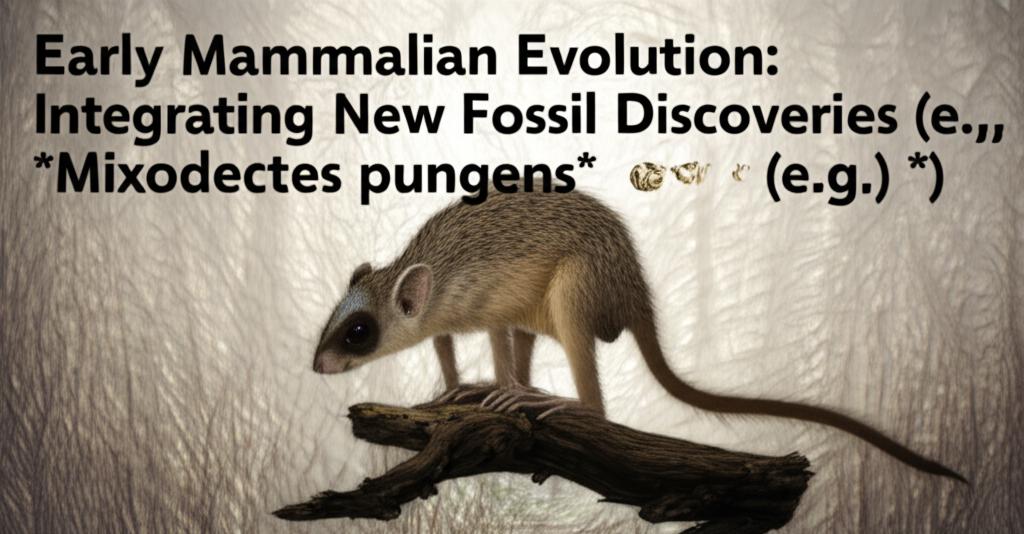The story of early mammalian evolution is constantly being updated with new fossil discoveries and advancements in analytical techniques. These findings are painting an increasingly detailed picture of how our distant ancestors diversified and adapted, particularly in the wake of the dinosaur extinction.
*The Significance of Mixodectes pungens**
A recent spotlight has fallen on Mixodectes pungens, a small, tree-dwelling mammal that lived approximately 62 million years ago in what is now western North America, during the early Paleocene epoch. For over 140 years, since its initial description by paleontologist Edward Drinker Cope in 1883, Mixodectes remained an enigma, known primarily from fragmented teeth and jawbones.
However, the discovery of a remarkably complete skeleton of Mixodectes pungens in New Mexico's San Juan Basin has provided a wealth of new information. This new specimen has allowed scientists to reconstruct its anatomy, infer its lifestyle, and refine its position on the mammalian evolutionary tree.
Studies of this new skeleton reveal that Mixodectes was an arboreal (tree-dwelling) mammal, weighing about three pounds. Its limb and claw anatomy suggest it was adept at climbing and clinging to tree trunks and branches. Analysis of its molar teeth, which had crests for breaking down abrasive material, indicates it was primarily a folivore, meaning it fed on leaves. This is a significant finding, as it shows how early placental mammals diversified ecologically after the Cretaceous-Paleogene extinction event that wiped out the non-avian dinosaurs.
Phylogenetic analyses based on this new, more complete data confirm that mixodectids, the extinct group to which Mixodectes belongs, are euarchontans. This group includes modern treeshrews, primates (including humans), and colugos (also known as flying lemurs). More specifically, the analyses place mixodectids within Primatomorpha, a subgroup of Euarchonta that comprises primates and colugos, making them relatively close evolutionary relatives of humans. While the exact placement within primatomorphans is still debated (some analyses suggest they are archaic primates, others do not), the new findings significantly narrow down their evolutionary relationships.
Mixodectes was relatively large for a tree-dwelling mammal in North America during the early Paleocene. It shared its forest habitat with other early mammals, such as Torrejonia wilsoni, a smaller, fruit-eating plesiadapiform (an extinct group of early primate relatives). These differences in size and diet suggest that Mixodectes occupied a distinct ecological niche, highlighting the adaptive radiation that occurred as mammals filled ecological roles vacated by the dinosaurs.
Broader Insights from New Fossil DiscoveriesThe revelations about Mixodectes are part of a larger trend where new fossil discoveries are reshaping our understanding of early mammalian evolution:
- Earlier Diversification and Complexity: Contrary to the older view that early mammals were small, shrew-like creatures that only diversified after the dinosaurs disappeared, recent finds demonstrate significant ecological and locomotor diversity among mammaliaforms (mammals and their closest extinct relatives) during the Mesozoic Era, the "Age of Dinosaurs." Fossils from China, for instance, have revealed tree-dwelling, gliding, and burrowing mammaliaforms from the Jurassic period, much earlier than previously thought.
- Evolution of Key Mammalian Traits: Discoveries of cynodont fossils (mammal precursors) in Brazil are shedding light on the evolution of defining mammalian characteristics, such as the jaw structure and the three middle ear bones. These fossils suggest that some "mammalian" traits evolved multiple times independently in different cynodont lineages and much earlier than previously believed. This indicates that early mammalian evolution was a complex, mosaic process with various evolutionary "experiments."
- Tooth, Jaw, and Ear Evolution: New Jurassic-era fossils from China, such as Feredocodon chowi and Dianoconodon youngi, are providing critical missing links in understanding the transition from the reptilian jaw joint (with multiple bones) to the mammalian middle ear (with three tiny ossicles derived from former jaw bones). These fossils show a gradual modification where the jaw joint's load-bearing function was reduced as bones became specialized for hearing.
- Dietary and Locomotor Adaptations: Discoveries like Agilodocodon scansorius (an early tree-dweller adapted to eat tree sap) and Docofossor brachydactylus (an early subterranean digger) from the Jurassic of China highlight that specialized diets and modes of locomotion evolved very early in mammalian history.
- Early Social Behavior: Fossil evidence from Montana of Filikomys primaevus, a multituberculate mammal from the Cretaceous period, suggests that social behavior, including the association of different age groups, may have evolved in mammals much earlier than previously assumed, even while dinosaurs still roamed.
- Post-Extinction Recovery and Radiation: The Paleocene epoch, immediately following the dinosaur extinction, was a critical period for mammalian diversification. Fossils like Kimbetopsalis simmonsae, a large multituberculate from the early Paleocene of New Mexico, show that some mammal groups not only survived the extinction event but thrived and diversified rapidly in the new world order. The fossil record indicates a massive diversification of mammals within the first 10 million years of the Cenozoic era.
The integration of fossil discoveries with advanced analytical techniques, such as CT scanning for digital reconstruction of delicate structures and refined radioisotopic dating methods (like Argon-Argon dating), is crucial for these new insights. Furthermore, combining morphological data from fossils with molecular data from living mammals in phylogenetic analyses helps to build a more robust and comprehensive understanding of the mammalian family tree.
In conclusion, the field of early mammalian evolution is vibrant and dynamic. Each new fossil, like the remarkably complete skeleton of Mixodectes pungens*, acts as a crucial puzzle piece. When combined with other discoveries and modern analytical approaches, these finds are progressively illuminating the intricate pathways and remarkable adaptations that characterized the rise of mammals, including our own deep evolutionary roots.

